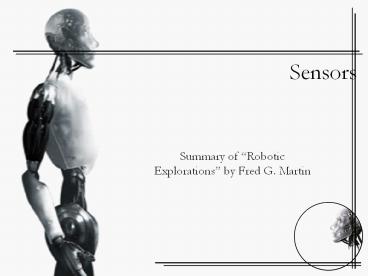Sensors - PowerPoint PPT Presentation
1 / 15
Title:
Sensors
Description:
Potentiometer ... The Linear taper potentiometer has a linear relationship ... The Audio taper potentiometer has a logarithmic relationship between position ... – PowerPoint PPT presentation
Number of Views:1133
Avg rating:3.0/5.0
Title: Sensors
1
Sensors
- Summary of Robotic Explorations by Fred G.
Martin
2
Sensor Types
- Digital
- Reading is either 0 or 1
- Analog
- Reading increases/decreases gradually from 0 to 1
1 0
1 0
Analog
Digital
3
Sensors Circuitry
- Digital (Switch) Sensors open/close circuits
- When switch is open, voltage (5V) goes into the
port - When it is closed, voltage is transferred to
grounding
4
Sensors Circuitry
- Analog (Resistance) Sensors alter voltage
gradually - Sensors (one or two) act like resistors in a
voltage divider to gradually change voltage - When resistance in R1 is increased/decreased,
output voltage decreases/increases - When resistance in R2 is increased/decreased,
output voltage increases/decreases
5
Signal Interpretation
- Digital Sensors
- Pressed closed connected to ground 0 volts
reading logical 1
6
Signal Interpretation
- Analog Sensors
- Signal is converted to a 8-bit binary number
(respectively 0 to 255 in decimal) through an
Analog-to-Digital conversion, depending on the
voltage that is detected from the circuitry.
R1 gt R2 less resistance to the grounding
(0V) R1lt R2 less resistance to the voltage
source (5V) R1 R2 equal resistance Vout
2.5V
7
Switch Sensor Examples
- Contact (Bump) sensor
- Physical contact with another
- object
- Limit sensor
- Mechanism (manipulator) has
- moved to the end of its freedom
- Shaft encoding
- Counts the clicks of a turning
- shaft to count revolutions
8
Analog Sensor Examples
- Photocell (light) sensor
- More light less resistance. Therefore, sensor
reports small values when illuminated and large
values when in dark.
Counterintuitive to How much light is there?,
therefore we need to convert this int light(int
port) return 255 analog(port)
9
Analog Sensor Examples
- Differential Light Sensor
- Determines which sensor detects more light
Left More light (less resistance) closer to
5V Less light (more resistance) closer to
0V Right More light (less resistance) closer
to 0V Less light (more resistance) closer to 5V
Possible application light seeking program
turn to the side of the sensor that detects more
light
10
Analog Sensor Examples
- Bend Sensor
- Like a photocell, the bend sensor acts as a
resistor as it is bent, the resistance
increases thus, readings close to 5V occur when
the sensor is bent, and readings close to 0V
occur when it is straight.
Possible applications contact sensing, wall
tracking
11
Analog Sensor Examples
- Potentiometer
- Sliding / Rotating mechanisms that determine the
resistance between the two ends of a circuit
(left and right ends)
The Linear taper potentiometer has a linear
relationship between position and resistance
good for motor control. The Audio taper
potentiometer has a logarithmic relationship
between position and resistance used primarily
for volume control.
12
Analog Sensor Examples
- Optosensors
- Active sensors that are combination of a LED and
a light-detecting photodiode - Two types
- Reflective LED and photodiode are in line,
facing same direction - Break-Beam LED and photodiode are facing each
other
13
Analog Sensor Examples
- Reflective Optosensor
Possible applications Object detection
determining the presence of an object and the
distance to it Surface feature detection
detecting painted, taped, etc. marks Wall
tracking wall is a continuous object that can
be detected
Rotational shaft encoding using a pie shaped
encoder wheel, the reflectance sector can measure
the rotation of a shaft Barcode decoding can be
used to decode information from barcode markers
placed in the robots environment
14
Analog Sensor Examples
- Break-Beam Optosensors
Possible applications Slotted shaft encoder
wheel with one LED on one side and a photodiode
on the other will suffice to more precise shaft
velocity since there is no possibility for
reflection problems. It could also work as a
linear velocity sensor, using a slotted Lego
beam, for example.
15
Analog Sensor Examples
- Pneumatic pressure sensors
- An analog equivalent of a bump sensor
Possible applications For measuring physical
pressure, for more precise motor control near
obstacles, as bump detectors may sometimes fail
to work on time to stop motor.































